|
|
Post by keen101 (Biolumo / Andrew B.) on Sept 4, 2018 13:24:56 GMT -5
I don't know that descriptions would really help. Not unless they were in excruciating detail, and in a wide genetic varying species, you would have yo account for the variation. I think pictures would be more helpful as a generic reference.
Perhaps the TGRC and/or Bedinger at Colorado State University could help if we asked them.
But i found that old key we were looking at awhile back to be practically useless to me.
|
|
|
|
Post by Joseph Lofthouse on Sept 4, 2018 13:34:22 GMT -5
The only pilose fruits that I have seen were on S habrochaites. The longer I play with plant breeding, the more of a lumper I become... I'm currently growing inter-species hybrids of squash, corn, beans, and tomatoes. Here's an interesting taxonomic analysis. vcru.wisc.edu/spoonerlab/pdf/Tomatomonograph.pdf |
|
|
|
Post by Joseph Lofthouse on Sept 4, 2018 13:38:06 GMT -5
Also i think I've heard it said that the genetic variation in peruvianum as a species is far more than domestic tomatoes, pimp., cheesmaniae, and galapagense combined. Or something like that. The self-compatible tomatoes are tending towards constantly loosing genetic diversity because of selfing. The peruvianum complex, which are generally obligatory out-crossers are tending to hold onto genetic diversity. |
|
|
|
Post by keen101 (Biolumo / Andrew B.) on Sept 10, 2018 13:26:08 GMT -5
William Joseph Lofthouse, i will try to copy or scan the relevant information somehow, but the TGRC uses the F1 penelli hybrid line #1 as a rootstock for s. chilense. Perhaps that could help in getting flowers faster than otherwise. Again grafting could help... I am low on seed (only one seed for each of us left), but i have packages ready where i am sending you the pennelli F1 hybrid line #2 (LA4488) that has a different domestic mother and some disease resistance in the domestic line. It would also be clever to try to backcross to pennellii, but i am out of seed.
|
|
|
|
Post by Joseph Lofthouse on Sept 13, 2018 11:52:36 GMT -5
So, if we have Solanum arcanum, it's possible things might be easier for us in the crossing department? Some of the plants that I'm growing keyed out as S arcanum. I'm not much trusting the species splitting in the S peruvianum complex. |
|
|
|
Post by keen101 (Biolumo / Andrew B.) on Sept 13, 2018 16:08:16 GMT -5
So, if we have Solanum arcanum, it's possible things might be easier for us in the crossing peruvianum Maybe. I'm not going to go that route myself. I personally doubt that is the only way. |
|
|
|
Post by philagardener on Sept 14, 2018 5:34:47 GMT -5
Thanks for sharing - great countryside!
|
|
|
|
Post by keen101 (Biolumo / Andrew B.) on Sept 14, 2018 7:56:07 GMT -5
It continues to intrigue me that our S. Corneliomuelleri isnt. Maybe you already have S. Arcanum.. |
|
|
|
Post by Joseph Lofthouse on Sept 15, 2018 7:30:36 GMT -5
Yep gotta scratch Cornelio-Muelleri and put in Arcanum? The seed that came to me was labeled as Lycopersicon glandulosum. That's a really old name, perhaps from before the peruvianum complex was split. It translates to corneliomulleri... The plants had an astonishingly curved anther cone. Only around 5% of my plants keyed out as arcanum (straight anther cone/style). I'm intending to munge everything together into "Peruvianum complex", and be done with the splitting. |
|
|
|
Post by keen101 (Biolumo / Andrew B.) on Oct 6, 2018 13:14:41 GMT -5
Wondering how many accessions contribute to the Peruvianum complex we've been growing. Andrew, your Peruvianum was independently obtained? Joseph have you added any new Peruvianum accessions to your complex? Also wondering about best way to cultivate S. Chilense in a northern climate. Well i found two packets. One from Peace Seeds labeled Solanum peruvianum wild Andean species tomato. And one LA0453 Yura #2, Arequipa Peru. Looks like maybe i selected this Accession based on dark orange flowers?? tgrc.ucdavis.edu/Data/Acc/AccDetail.aspx?AccessionNum=LA0453Not sure which (or if both) survived and flowered the first year. But i think i can feel a few residual seeds in the LA0453 packet and many seeds still left in the peace seeds packet. |
|
|
|
Post by Joseph Lofthouse on Oct 7, 2018 12:09:39 GMT -5
Wondering how many accessions contribute to the Peruvianum complex we've been growing. I started with: The accession (mis)identified as S corneliomulleri LYC 4292 (unknown species) LYC 2669 LYC 2822 LYC 3088 A year ago I added S peruvianum from Peace Seeds. These have been grown in close proximity to S chilense, S habrochaites, S pennellii, etc. I haven't kept records of which accessions actually produced seeds for me, but I planted seeds from the original accessions several years in a row. |
|
|
|
Post by Joseph Lofthouse on Oct 7, 2018 14:30:34 GMT -5
I didn't find any red/yellow/pink fruits among the population which I am calling BC1 because I am wondering if it is 75% S habrochaites. However, in that population, I found fruits with 3 locules, which is a trait that might be expected to show up among the descendants of interspecies hybrids. Also among the BC1 population, I found fruits that are larger than expected for S habrochaites, and some that seem to have a slightly more yellow tint to them. S habrochaites BC1 population, fruits with 3 or more locules.  The yellowish tint in the photo is a camera artifact. The fruits don't look yellow like that in real life. Solanum habrochaites and BC1  From Left to Right: Largest fruits from Solanum habrochaites BC1 Most yellowish fruits from S habrochaites and BC1 Fruits with 3 locules from S habrochaites BC1 Field run of fruits from S habrochaites selected during harvest for larger fruits. I didn't select S habrochaites or BC1 for taste this year. I selected fruits of S peruvianum based on taste. |
|
|
|
Post by Joseph Lofthouse on Oct 7, 2018 19:27:57 GMT -5
I got some BC1 fruits but left them all in the garden in hopes of volunteers- because the plants were completely indistinguishable from my neandermato clump. I have two phenotypes of S habrochaites in my garden. The giant plants, and the LA1777-type plants. I did a lot of staring at the BC1 population this summer, trying to discern any differences between LA1777-type and BC1. The only thing that really jumped out at me were the fruits with 3 locules. |
|
|
|
Post by keen101 (Biolumo / Andrew B.) on Oct 9, 2018 22:39:20 GMT -5
I harvested all remaining fruits tonight, watermelons, citron hybrids, wild tomatoes. It looks like while S. galapagense was flowering better than last year i got no fruits this year. too bad.  I got some Cheesmaniae, but they are still ripening. The unknown hybrid tomato was very interesting. Two seem to be ripening to Orange. I thought this was either a cheesmaniae hybrid or a pimpinellifolium, but i thought cheesmaniae has more yellowish fruits wheras galapagense has more of this kind of orange. Could this be a cheesmaniae-galapagense hybrid? what throws me off though are the green stripes on many of them. A galapagense-habrochiates hybrid?? interesting. odd, but cool. Sorry for the poor photos. Cheesmaniae photos first: 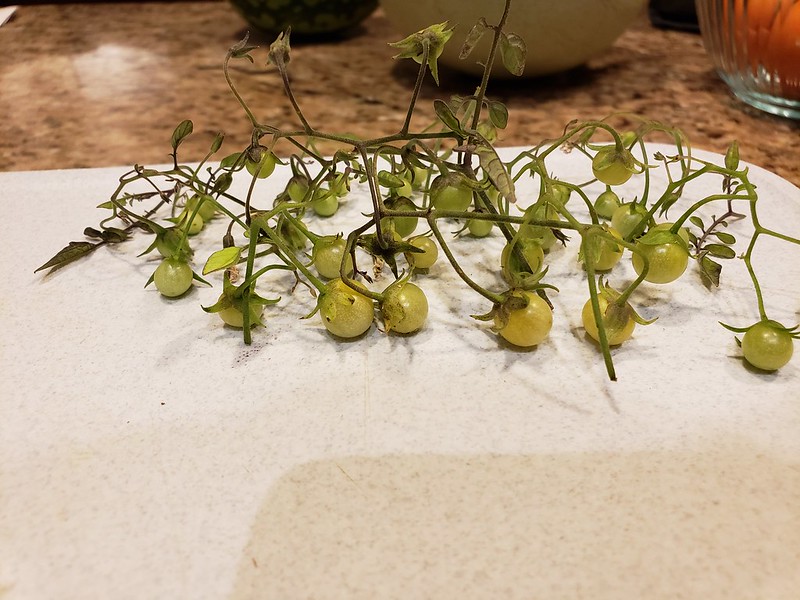 Wild tomatoes 2018 (2) Wild tomatoes 2018 (2) by Andrew Barney, on Flickr 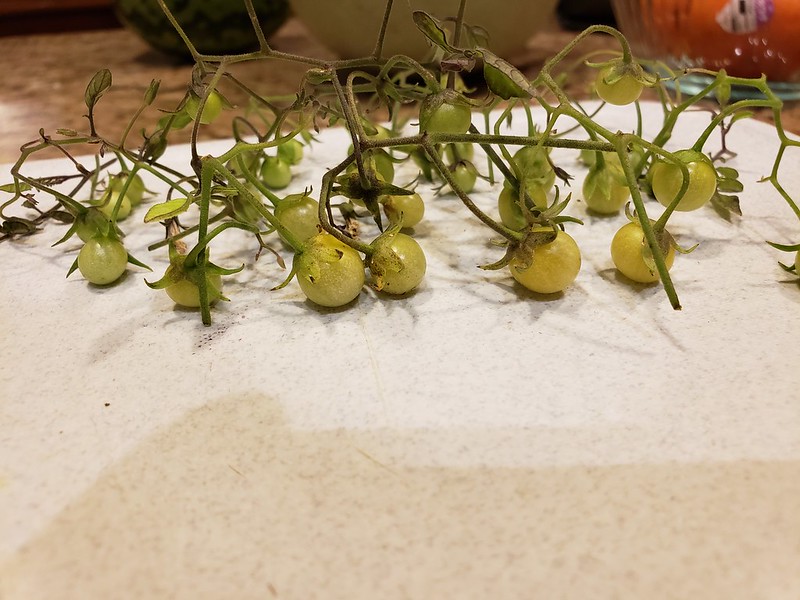 Wild tomatoes 2018 (2) Wild tomatoes 2018 (2) by Andrew Barney, on Flickr 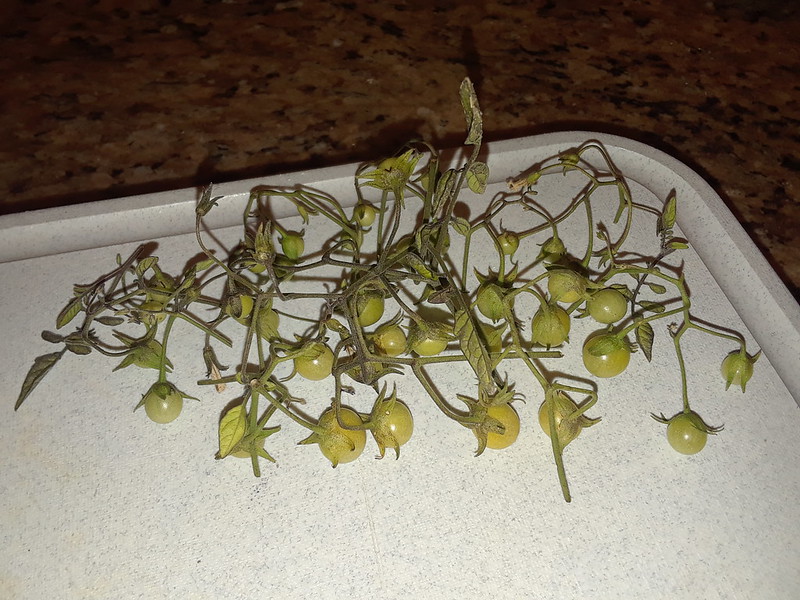 Wild tomatoes 2018 (1) Wild tomatoes 2018 (1) by Andrew Barney, on Flickr 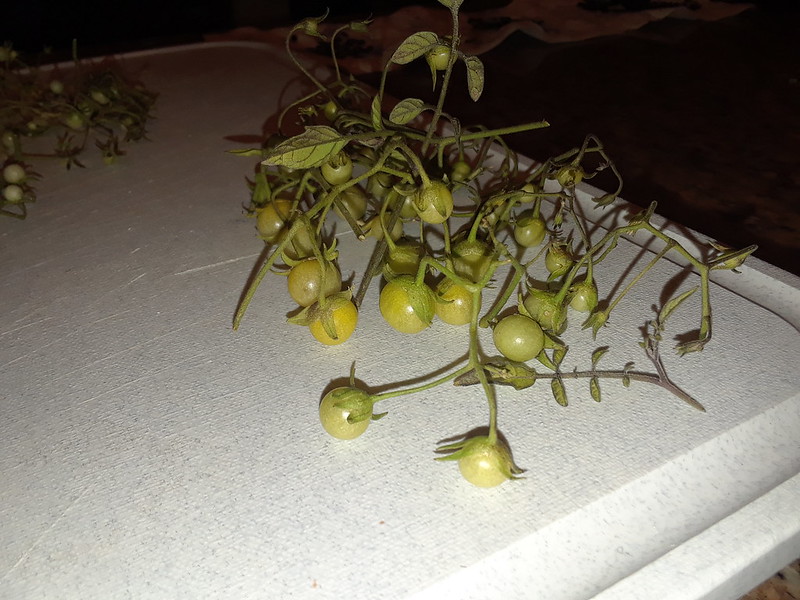 Wild tomatoes 2018 (1) Wild tomatoes 2018 (1) by Andrew Barney, on Flickr ----- Now the unknown wild tomato hybrid photos: 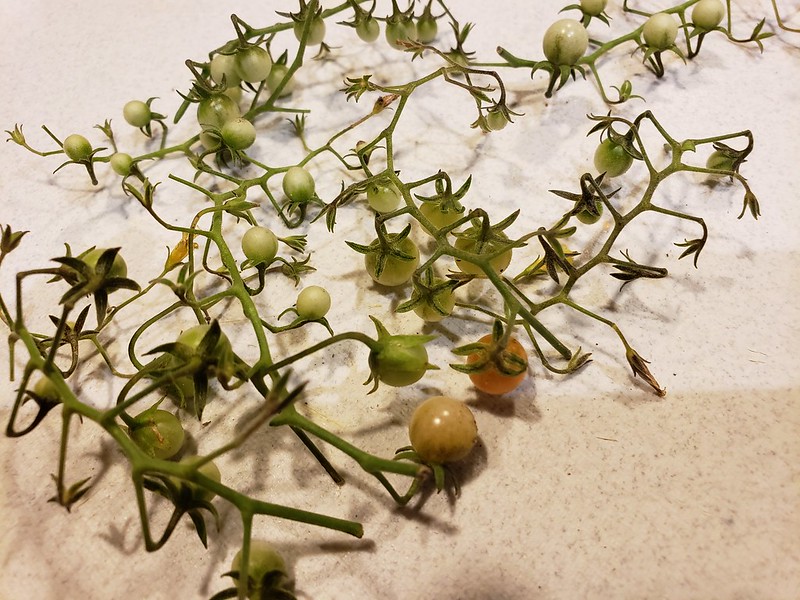 Wild tomatoes 2018 (2) Wild tomatoes 2018 (2) by Andrew Barney, on Flickr 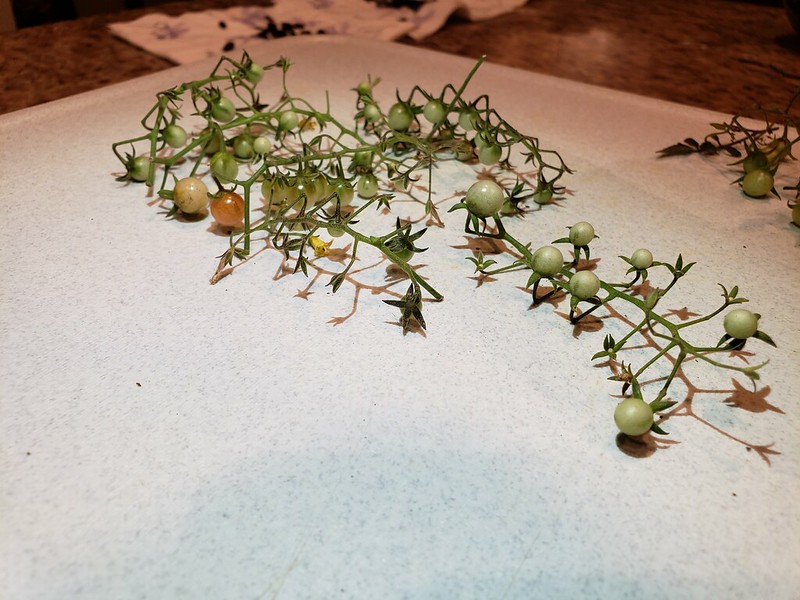 Wild tomatoes 2018 (2) Wild tomatoes 2018 (2) by Andrew Barney, on Flickr  Wild tomatoes 2018 (2) Wild tomatoes 2018 (2) by Andrew Barney, on Flickr  Wild tomatoes 2018 (2) Wild tomatoes 2018 (2) by Andrew Barney, on Flickr 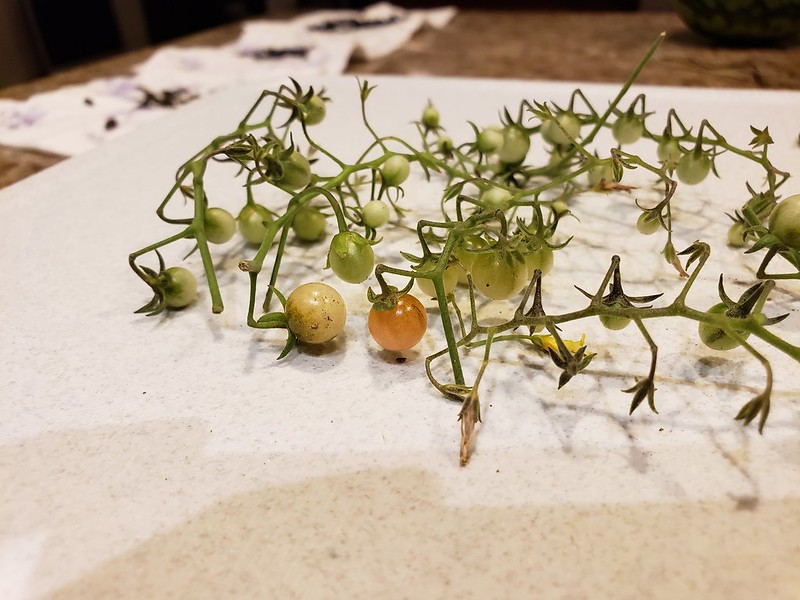 Wild tomatoes 2018 (2) Wild tomatoes 2018 (2) by Andrew Barney, on Flickr  Wild tomatoes 2018 (2) Wild tomatoes 2018 (2) by Andrew Barney, on Flickr 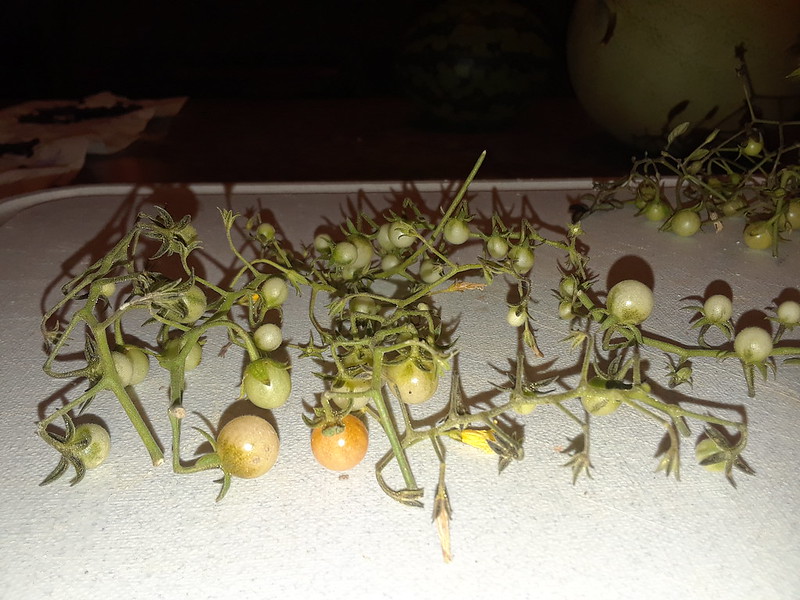 Wild tomatoes 2018 (1) Wild tomatoes 2018 (1) by Andrew Barney, on Flickr |
|
|
|
Post by imgrimmer on Aug 19, 2019 2:47:36 GMT -5
This year there are many plants with exposed stigmata. Some wild like pennelli, but also many of my own strains. I noticed that plants with exposed stigma are bad fruit setters.
There is a beef tomato right beside a pasta type with closed anthers beef has 2 fruits and pasta is covered in fruits.
There are 2 habrochaites hybrids right beside another one has exposed , one a covered stigma. The latter has already set fruits the first not a single one.
I was thinking about that and beside of individual traits i consider it a lack of pollinators.
So far I haven`t seen insects visiting tomato flowers (but it might be possible, at least it is very rare).
I wonder if there is a lack of specialised insects adapted to tomatoes here in Europe.
It is just an idea. Last year I thought it might be only a problem with the wild and their hybrids but it seems domestic tomatoes have the same problem...
Any observation about that?
|
|